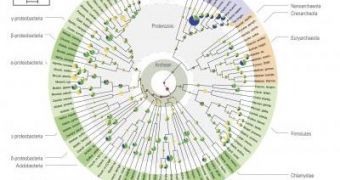MIT computational biologists analyzed thousands of genes from 100 modern genomes and managed to reconstruct a genomic fossil, telling not only when these genes appeared but also the ancient microbes they possessed.
Life on Earth rapidly changed 580 million years ago, in a period called the Cambrian Explosion, when over a period of many millions of years, new life forms were born, ultimately leading to today's modern animal diversity.
Since then, fossils have helped paleontologists picture the evolution of life, but what happened during the 3 billion years before this period is rather unclear, since the soft-bodied Precambrian cells left little fossil imprints.
They did, however, leave DNA fossil and since every living organism inherits its genomes, a team of computational biologists from MIT thought that they could use modern-day genomes to rebuilt the evolution of ancient microbes.
So they added information of the genome library to their own mathematical model, which considers the ways that genes evolve – genes can be born and inherited, swapped or horizontally transferred between organisms, duplicated in the same genome and also lost, and managed to get to the first appearance of those genes on Earth.
The results of their work suggest that the common genome of all life on Earth developed between 3.3 and 2.8 billion years ago, giving birth to 27% of all currently existing gene families.
The two scientists working on this research were Eric Alm, a professor in the Department of Civil and Environmental Engineering and the Department of Biological Engineering, and Lawrence David, who recently received his PhD from MIT and is now a Junior Fellow in the Harvard Society of Fellows, and they have named this period the Archean Expansion.
Since most of the genes they identified are related to oxygen, Alm and David first believed that oxygen could be responsible for the Archean Expansion, but after a closer look, they realized that it was impossible, since oxygen appeared at the end of the Archean Expansion, 2.8 billion years ago (the Great Oxidation Event that killed many anaerobic life forms).
Alm said that “the Great Oxidation Event was probably the most catastrophic event in the history of cellular life, but we don’t have any biological record of it.”
So the two scientists deepened their work and they came to believe that they have discovered the birth of modern electron transport.
All oxygen-breathing organisms use electron transport to do so, and plants and some microbes use electron transport during photosynthesis when they receive energy directly from the sun.
The researchers believe that a form of photosynthesis called oxygenic photosynthesis, is responsible for creating the oxygen from the Great Oxidation Event, and also the one we breathe today.
The evolution of electron transport during the Archean Expansion activated many stages in the history of life, photosynthesis and respiration included, generating and storing large amounts of energy in the biosphere.
David said that the “results can’t say if the development of electron transport directly caused the Archean Expansion.
“Nonetheless, we can speculate that having access to a much larger energy budget enabled the biosphere to host larger and more complex microbial ecosystems.”
“What is really remarkable about our findings,” Alm said, “is that they prove that the histories of very ancient events are recorded in the shared DNA of living organisms.
“And now that we are beginning to understand how to decode that history, I have hope that we can reconstruct some of the earliest events in the evolution of life in great detail.”
A paper describing their research was published in Nature online.

 14 DAY TRIAL //
14 DAY TRIAL //